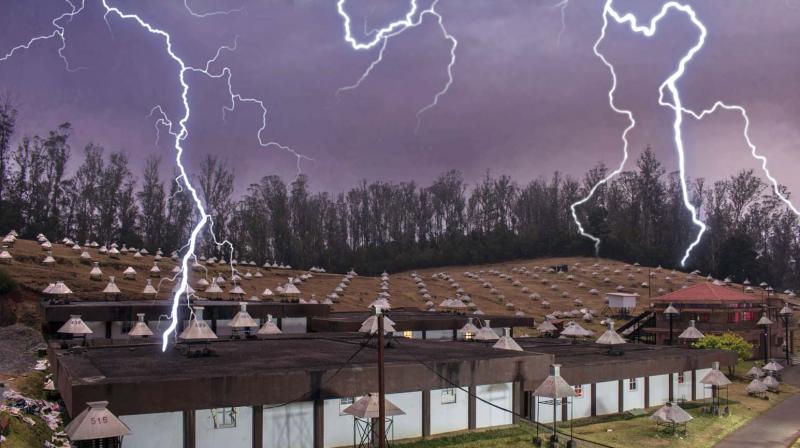Ooty: Cosmic Ray Lab breaks new ground with ‘Muon’ telescope

OOTY: On March 21, the day of spring equinox, wherein day and night are of approximately equal duration, an important day in annals of space research, the Cosmic Ray Laboratory(CRL) of the Tata Institute Fundamental Research (TIFR), located at the Melkavvatti road junction here, made the announcement of its phenomenal discovery on production of unimaginably high voltage in a thunderstorm.
It thus showcased India’s strength and capability in probing the atmosphere and space using the cosmic particles and taking the world along it to the next higher level of research in this field.
The CRL by using its ‘muon telescope’ has performed a wonder, answering the nearly century-old question of how to measure the high voltage produced in a thunderstorm. Thus the CRL has developed a tool in ‘muon telescope’ to discover the electrical potential in thunderstorm.
The lightning strikes that kill lives in a flash are caused by high voltage in thunderstorms. But, the actual voltage produced in the thunderstorms has been shrouded in mystery up until now. This mystery remained unresolved because the technology needed to measure this extra-terrestrial high voltage phenomenon was lacking all of these years. Though scientists of yesteryear made valiant attempts, the cutting-edge instrument needed for measuring the thunderstorm voltage was missing for nearly a century.
Scientists at CRL, who in 2016 made a thundering discovery of weakening of Earth’s magnetic shield due to a solar storm, have , now, discovered another startling discovery pertaining to the high voltage in a thunderstorm, which may pave way for applied science to benefit in the years to come.
Dr Sunil K. Gupta, head of CRL, explained that the thunderstorms are an amazing display by nature of thunder and lightning. By the muon imaging, the GRAPES-3 telescope (Gamma Ray Astronomy at PeV Energies Phase-3) at CRL showed a huge voltage of 1,300,000,000 Volts (1.3 GV) (130 crore volts in Indian terms) in a thunderstorm on 1 December 2014 in Ooty. The ‘muon’ is a sub-atomic charged particle that is produced when the cosmic rays travel through the atmosphere, he noted.
This voltage was present for the thunderstorm duration of 18 minutes. This voltage is 10 times larger than the previous record voltage of 0.13 GV. This verified 90-year old prediction of 1,000,000,000 Volts (1 GV) by C.T.R. Wilson (Physics Nobel 1927). Such massive voltages are needed to explain the production of high-energy (100 MeV) gamma rays in Terrestrial Gamma Ray Flashes, first discovered 25 years ago, he pointed out.
The ‘Grapes-3 muon telescope’ is a sensitive instrument operated by the CRL in Ooty, as a collaboration of several institutes and universities from Japan and India. Muon intensity changes due to thunderstorm voltage, which allowed scientists to calculate this voltage of 1.3 GV. Basically, higher the voltage in the thunderstorm, lower will be the muon intensity, he explained.
B. Hariharan used the computer cluster, a state of the art system developed at the CRL, to do extensive calculations to establish the exact relation between the muon intensity due to thunderstorm voltage which made the present phenomenal discovery possible. It took over nearly four years to complete and verify this work before making the final announcement of this discovery, he explained.

